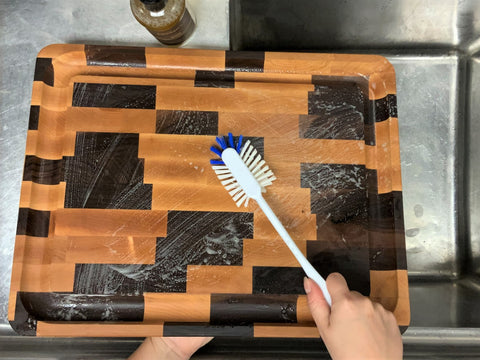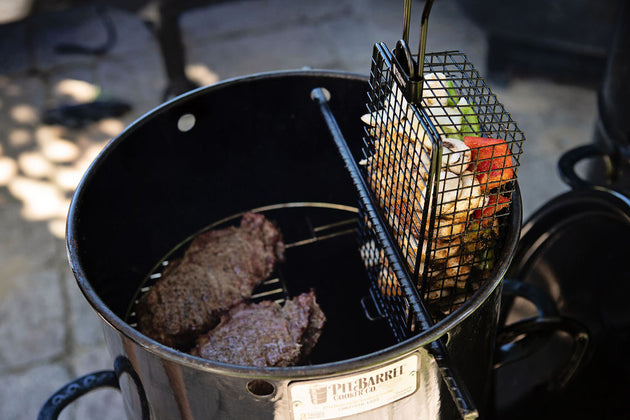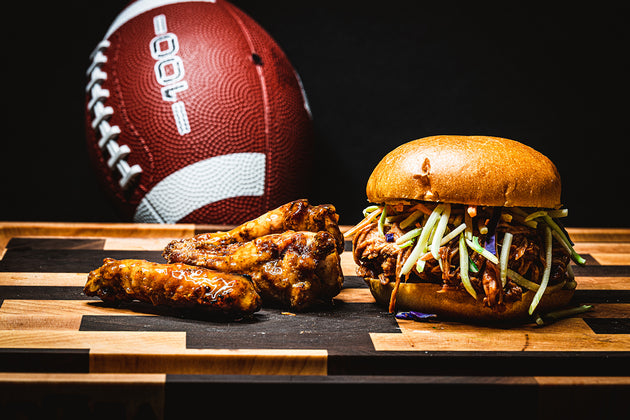At EndGrain, we take our premium end-grain wood cutting boards seriously. We know they’re one of the best investments a cook can make, and we want to ensure that our customers have the best experience with their EndGrain Cutting Boards, from purchase to receiving their board and beyond. Therefore, we would like to take this time to thoroughly go over how to clean and maintain your EndGrain Cutting Board so it will last for a lifetime.
What is an EndGrain Cutting Board?
First, allow us to describe what an EndGrain Cutting Board is and some basic housekeeping rules. EndGrain Cutting Boards are made of pieces of end-grain hardwood maple and black walnut, joined together using an FDA approved food safe waterproof glue. While wood can withstand liquid and water it’s not truly waterproof and if it becomes saturated with water it can warp and split. For this reason, we tell all our customers when they purchase an EndGrain Cutting Board to NEVER put it through the dishwasher or submerge it in water. Ever. We mean it. We know you made a careful choice to invest in an EndGrain Cutting Board and we want that investment to pay off.
Cleaning Your EndGrain Cutting Board
Every time after you use your EndGrain Cutting Board, you need to clean it as soon as possible. This helps mitigate any stains and odors that might become attached to the surface. We’ll cover some basic stain and odor removal tips in another blog post; for now, we want to focus on basic cleaning and maintenance. A sponge with an anti-scratch scrubbing surface, a sturdy dishcloth, or a nylon bristled dish brush are the tools we recommend for removing larger food particles from the cutting boards surface. If you find food particles are being more stubborn you can use a flat, steel bench scraper or spatula to remove those stubborn bits. There are hard silicone pot scrapers available for purchase in most kitchen stores and are extremely useful for removing any larger food particles that may be resistant to removal. NEVER use a steel brush or steel wool, these items will scratch and damage the surface of the board, which can provide more areas for microbes to hide.
Once you’ve removed the visible food particles, quickly and gently wet the surface with warm to hot water and place a little of the EndGrain Cutting Block Soap on it. With a sponge, dishcloth, or dish brush scrub in a circular motion, paying close attention to move all around the board (edges and bottom, too). This will remove all non-visible food particles and any microbes that might be hiding on the surface. The longer you work up the suds the more the soap can lift any dirt and food particles left on the surface. If you don’t have EndGrain Soap at hand, a mild dish soap is also effective.

After you’ve cleaned your board, rinse it off thoroughly and dry it immediately using a lint-free towel. Paper towels can work in a pinch, but they will leave behind some fuzz, which is harmless, but not pretty. Then set your board on its edge in a dishrack to dry for at least an hour, but overnight is preferred before the next step. Feel it with a dry, clean hand, if it’s still damp, give it more time to dry before proceeding with oiling.

Maintaining Your EndGrain Cutting Board
Step 1: Oiling
When your EndGrain Cutting Board is dry you want to apply the EndGrain Cutting Block Oil to every surface of the board: top, bottom, all the juice channels, spillway, and edges. Never use any kind of organic oil or an oil you might cook with, like coconut, olive, canola, walnut, etc. These can become rancid over time and may leave your board with an unpleasant odor and can impart unpleasant odors and flavors to your food.
There are several methods for applying the EndGrain Cutting Block Oil to your cutting board.
- Single-use, food safe nitrile gloves (or vinyl): At our workshop our team uses single-use food safe nitrile gloves to apply the oil to our boards. This gives you the most dexterity when handling the board during oiling to ensure each side of the board is adequately covered.
- You can use a lint-free dusting cloth or a lint-free kitchen towel. Keep in mind that once you’ve put oil on one of these cloths it can’t be used for anything else until its washed, but it can be used for multiple oil applications. A note of caution: towels and dishcloths are absorbent by nature and will soak up some of the oil instead of being administered to the cutting board.
- Wrap a kitchen sponge in plastic wrap and use that to apply the oil to the board’s surface. The plastic will act as a barrier and prevent the oil from being sucked up into the sponge.
We also recommend doing this on top of some paper towels or a countertop covered with plastic wrap, to prevent the oil from getting all over your work surface. After applying the oil, you will again set the board on its edge to finish absorbing the oil, for at least 1-2 hours or overnight. You can wipe off any excess that may remain.

Step 2: Waxing
The final step in the maintenance process is waxing. Our EndGrain Cutting Block Wax is formulated using beeswax, carnauba wax, and lemon and orange essential oils. This combination helps create another defensive layer that preserves the durability of your cutting board. The process is like oiling your cutting board: apply evenly to all surfaces of your board (edges, juice grooves, top, bottom, spillway) and allow the wax to sit and harden for a couple hours or overnight. Then buff off the excess using a lint-free towel or lint-free dusting cloth reserved for this purpose.

The final step in care and maintenance of your EndGrain Cutting Board is to ensure that your board lives where it won’t be exposed to excess moisture or changes in temperature. In a kitchen this means you want to store your board away from the refrigerator, oven/range (when it’s in use), and dishwasher. These kitchen appliances can throw off enough residual heat and moisture to cause warping in your board overtime.
By taking proper care of your EndGrain Cutting Board your investment will truly pay off and your EndGrain will become a family heirloom that can be passed down to the next generation.




